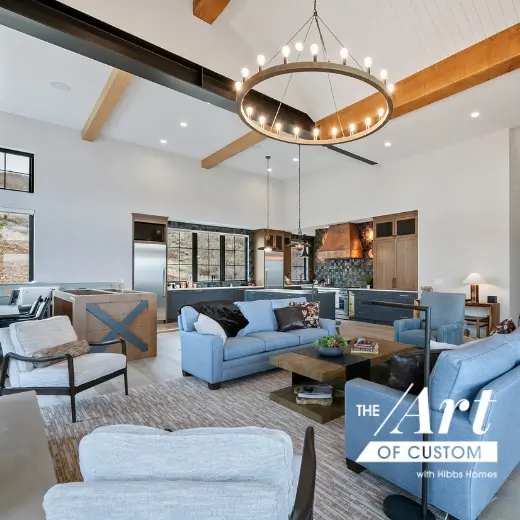The Art of Custom Home Selections & Finishes
Your home build + design team help you define and bring your vision for your dream home vision to life. But how do you communicate that vision? And what is the best approach to working with your builder to manage all of the details big and small?
In this episode we talk with Anna Entringer, a member of the Hibbs Luxury Homes in-house design team in St Louis, and one of our Park City custom home building partners, Kylie Blackwell. Stephen Landcaster from Pella Windows and Doors also joins us to discuss the massive impact your door and window selection has on your home's design and comfort.
EPISODE TOOL BOX
DOWNLOAD: Guide to Allowances & Selections

Season Three, Episode Seven | Transcript
Making design selections for a custom home can be one of the most exciting and overwhelming parts of the process.
In this episode, the Hibbs Homes design team breaks down how to stay organized, manage budgets, and make smart choices that bring your home’s personality to life.
The conversation also covers current design trends, how to prepare for selections meetings, and what to consider when choosing windows, doors, and finishes that affect performance and style.
The episode wraps with an expert from Pella Windows & Doors, who shares insight into window types, materials, and how the right choice can improve energy efficiency and home comfort.
Planning for the Selections Process
The selections process begins long before construction starts. Homeowners who prepare early and stay organized enjoy a smoother experience and fewer surprises.
Preparation tips:
- Collect inspiration images from Pinterest or Houzz to clarify your personal style.
- Identify both what you like and what you don’t—this helps your design team narrow options faster.
- Visit model homes or open houses to see finishes and materials in person.
- Stay flexible and patient—design decisions evolve as the home takes shape.
Using project-management tools like JobTread or CoConstruct keeps all communication, budgets, and selections in one place, helping clients and builders stay on the same page.
Organization and Communication
Clear communication is the key to keeping selections enjoyable instead of stressful. A well-organized builder will have a defined process, an order for making decisions, and deadlines that align with construction milestones.
Selections like windows, doors, and appliances often need to be made first due to long lead times. When clients understand this sequencing, it reduces stress and avoids costly delays.
Organization also helps balance creative choices with budget goals—allowing homeowners to splurge in some areas and save in others without losing overall design cohesion.
Staying on Budget
Budget discussions begin with understanding industry standards, which are average price ranges collected from builders nationwide for cabinetry, flooring, lighting, plumbing fixtures, and more.
These benchmarks provide a starting point for setting realistic allowances. From there, homeowners can adjust based on personal priorities:
- Invest more in high-impact areas like kitchens and primary baths.
- Offset upgrades by saving on lower-priority finishes such as interior hardware or secondary flooring.
- Remember that budgets are flexible when communication is clear and trade-offs are intentional.
Early selections also improve budgeting accuracy, helping avoid redesigns or value-engineering later in the process.
Finish Levels and Value Engineering
Custom homes typically fall within a finish range: basic, mid-grade, or high-end. Understanding where your project fits helps guide selections and control costs.
Value engineering by refining design choices for efficiency of budget and usage allows homeowners to achieve the same aesthetic for less. Examples include:
- Using one type of carpet throughout secondary bedrooms.
- Selecting a single hardwood species across main living areas.
- Planning countertop layouts to optimize slab usage and reduce waste.
Working with the design team early ensures the right materials are chosen to fit both the budget and the home’s architectural style.
Trends in Home Design and Finishes
Design trends continue to evolve, and clients are embracing warmth, texture, and individuality.
Current highlights:
- Mixed metals and layered finishes add character and depth.
- Pops of color and bold wall treatments are replacing all-white interiors.
- 3-D tile, mood lighting, and accent walls create visual interest.
- Warm neutrals, gray-beiges (“greiges”), and deep earth tones are replacing cooler grays.
- Natural materials like wood and soapstone bring organic warmth.
- Functional design has become a dominant priority.
Post-2020 lifestyles inspired homeowners to focus on comfort, personalization, and mood—creating homes that feel welcoming and expressive.
Guiding Clients Through Choices
Designers guide clients through each phase with patience and creativity. The goal is to achieve a cohesive design that reflects the homeowner’s personality while respecting budget and schedule.
Key advice:
- Stay focused on your overall vision to avoid “Pinterest paralysis.”
- Trust the builder and design team’s expertise when navigating options.
- Expect ups and downs. Construction has busy and quiet phases, but communication keeps everything on track.
- Remember, collaboration and trust turn the process into a rewarding experience.
Windows as a Key Design Element
The second half of the episode highlights the role of windows in both style and performance.
Material options:
- Vinyl: Cost-effective and durable for moderate climates.
- Fiberglass: Dimensionally stable and energy-efficient; ideal for black or dark finishes.
- Wood-Clad: Luxury appearance with an exterior aluminum shell for durability.
- Composites: Blend strength and efficiency at a mid-range price point.
Window styles:
Single- and double-hung, casement, sliding, and fixed glass panels each offer different aesthetics and performance benefits. Casement windows generally seal more tightly, improving energy efficiency.
Energy Efficiency and Glass Technology
Modern window design plays a crucial role in overall energy performance.
- Double vs. Triple-Pane Glass: Triple panes provide superior insulation but add cost; many builders use double panes with enhanced coatings instead.
- Low-E Coatings: Advanced glazing reflects UV rays to reduce heat gain and fading.
- Solar Orientation: Proper placement and overhangs control sunlight and heat throughout the year.
Homeowners can mix glass types within a home by using upgraded glazing or triple panes only on sun-exposed elevations for optimal performance and value.
Large Glass Doors and Outdoor Living
Sliding and folding glass walls are one of today’s most requested design features. Homeowners are seeking expansive openings, typically between 12 to 20 feet wide, that blur the line between indoor and outdoor spaces.
Materials like fiberglass and aluminum-clad wood offer strength and weather resistance. Proper installation, flashing, and overhangs are essential for long-term performance, especially in humid or four-season climates.
Choosing the Right Window Partner
Selecting the right window brand is about fit, performance, and installation quality. Many builders work with trusted manufacturers, but clients should always feel empowered to compare options.
Consider:
- Warranty and service availability.
- Design flexibility and customization.
- Energy performance ratings (U-value, design pressure).
- Installation quality—proper flashing and sealing are as critical as the window itself.
Windows influence both the look and performance of a home, affecting energy use, daylight, and comfort for years to come.
Wrapping Up
The selections phase is where a home’s personality comes to life. When homeowners stay organized, communicate openly, and trust their team, the process becomes one of the most rewarding parts of the build.
From paint colors to performance windows, every decision contributes to how the home feels, functions, and reflects its owners.
Special Thanks to Our Sponsors...



